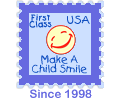I found this on another blog and copied it all to share with you! Please visit these blogs and see what else they have to say about the CPSIA law!! Help fight this law and continue to buy handmade!!
Please, take action. This affects everyone.
This is a blog post on Boutique Cafe by Heather.
The Sky is Falling - CPSIA Issue
December 17th, 2008
Article by: Heather Flottman
Owner/Designer
liliputians NYC
The sky is falling! Yes, I feel a like an overly dramatic Chicken Little. And I wish it were true considering recent congressional legislation is about to crush the life out of the handmade clothing and toy industry. I’m talking about H.R. 4040, the Consumer Protection Safety Improvement Act (CPSIA) signed into law August 14, 2008, and the ramifications it will have when it goes into effect February 10, 2009 (now being popularly referred to as National Bankruptcy Day).
Make no mistake. CPSIA was necessary in principle and has noble intentions, keeping our children safe and holding companies accountable for importing toxic toys. We all demand safety for our children and this is the intent of CPSIA; specifically to ensure safe levels of lead and phthalates in all products manufactured for children under the age of 12. Unfortunately this legislation lacks common sense, is ambiguous and fails to take into account the handmade industry.
What you see is not what you get with CPSIA. There is no distinction between big, small, or even micro one-person businesses. Whether it’s a large-scale manufacturer importing apparel to be sold in big box stores, or a work-at-home mom (WAHM) selling customs on ebay, the legislation applies the same to all.
Unit testing will be required on finished products, regardless if the components are natural materials or if you have documentation from a vendor stating that buttons, for example, are certified lead-free. As it stands, H.R. 4040 fails to recognize that textile products are inherently lead-free. Why then is an organic cotton shirt being tested for lead exactly?
Unit testing is extremely cost prohibitive to small business, but worse, it is unnecessary. In fact, it is completely redundant if the components that comprise the whole have already been tested and due diligence can prove they meet the guidelines.
To put a real dollar amount to testing one of my products, I solicited a lab quote. I was told it was $75 to test for lead per garment component and each substrate. Coated or painted items such as buttons are $100. So my Little Red Riding Hood Shirt, a 100% cotton knit shirt with an appliqué made from 7 cotton fabrics and 2 buttons eyes would cost $625 to test for lead. Flammability testing is also required and is either $50 for a certificate per component stating it meets weight code or $100 for actual testing. So add another $400-$800 for a grand total of $1,025-$1425. in testing costs for a shirt that retails for $40. If the shirt is offered in another colorway, the same testing is required despite the fact that the same fabrics are used throughout.
Small manufacturers have no way of absorbing the price of such redundancy. And all manufacturers will be required to test a finished component/item from each batch. Easy to do in mass production—simply pull one sample from a lot of thousands. But how does one comply when your “batches” are made-to-order batches of one? SKUs will also be required for each product with a permanent label on the item itself.
CPSIA will be retroactive and takes a guilty-until-proven-innocent approach with extremely hefty fines for violators. As written, any product used by children 12 and under (such as toys, footwear, carpets, clothing, bedding, luggage, lamps, toys, books, magazines, baseball cards, consumer electronics, school supplies, office supplies, jewelry, housewares, sports equipment and so on) without the newly required certification would be deemed hazardous, whether the item poses an actual threat or not. So on February 10, 2009, any unsold merchandise (in big box stores, the corner boutique, your fabric stash, Good Will donations, etc.) will be deemed “hazardous goods” and illegal to sell unless 3rd party testing proves otherwise. By the way, there are only 14 said labs currently in the United States.
Think you won’t be affected? I hope not, but the sad truth is that hundreds of thousands (if not millions) will be. Do you make children’s clothing, toys, jewelry, hair bows, accessories, furniture, artwork or anything else “intended for use by children age 12 and under”? Are you a retailer of children’s goods? Do you resell used children’s clothing or toys on ebay? Do you participate or shop at craft fairs? Do you donate used children’s items to needy organizations? Do you belong to a church that has rummage sales as a fundraiser? Does your child play sports and get their uniforms from a local screen print shop? Are you a consumer shopping for alternatives to mass-produced toys? If so, this law takes away that freedom.
Surely this legislation can be amended by incorporating some common sense and still make it possible to ensure our children’s safety without further hurting the US economy. According to the 2002 Economic Census (the last survey of its type), small U.S. clothing manufacturers (with fewer than 20 employees) contribute over $900 million dollars [consider: nearly $1 billion dollars] annually to the economy and comprise 68% of total apparel manufacturing in the U.S. This is clearly a vital and contributing asset to our economy. Multiply this fallout exponentially when you take into account the myriad other manufacturers, retailers and businesses that will be hurt or ultimately driven out of business.
So, why should you support amending this legislation?
Because the CPSIA isn’t fair and will not function as written. It inadvertently punishes American industries unrelated to toys and will ultimately result in fewer alternatives to mass produced merchandise made in China. The concept that small producers should be subject to the same rigorous standards but with lesser regulation (and common sense) has already been fought for and sustained in the food industry, which is why your local farmers market still exists. Now this same idea needs to be applied to children’s products.
What can you do?
1) Email or call the CPSIA - the office of the CPSC ombudsman 888-531-9070.
http://www.cpsc.gov/cgibin/newleg.aspx
Comments on Component Parts Testing accepted through January 30, 2009.
mailto:Sec102ComponentPartsTesting@cpsc.gov.
2) Email or snail mail your representatives.
http://capwiz.com/americanapparel/issues/alert/?alertid=12274476
3) Call your representatives. For their contact information just enter your zip code.
http://capwiz.com/americanapparel/dbq/officials/
4) Make your voice heard by voting on this issue. The top 3 in each category will be presented to President-elect Obama.
http://www.change.org/ideas/view/save_handmade_toys_from_the_cpsia
5) Sign the petition.
http://www.ipetitions.com/petition/economicimpactsofCPSIA/index.html
6) Spread the word! Write about this on your blog. Tell others about this issue and encourage them to do the same.
7) Join others in fighting this cause.
Facebook group
Twitter search
http://cpsia-central.ning.com/notes/Notes_Home
Join the etsy community in the virtual chat with CPSIA Small Business Ombudsmen or send a handmade children’s item that will become “hazardous goods” as of 2/9/09 to Bobby Rush, founder of H.R. 4040.
http://www.etsy.com/storque/craftivism/handmade-childrens-items-unintended-consequences-consumer-pr-3056/
Etsy Thread
9) Read more about this legislation and its ramifications:
Fashion Incubator
Handmade Toy Alliance
National Bankruptcy Day
5 Minutes for Mom
Cool Mom Picks
The Smart Mama
blogher
Apparel and Footwear.org
Toy Association.org
Cafe Mom
Safety and Compliance
Zrecommends
SleepingBaby.net
Freshly Baked Blog
~Dawn
Monday, December 29, 2008
More on the CPSIA Law- I had to share!
Posted by Sweet Pea Cakes Etc. Blog at 10:05 PM 1 comments
Monday, December 15, 2008
Find out more about CPSIA and how you can help!
I found a lot of blogs that have information on this new law, CPSIA- Consumer Products Safety Improvement Act, and how it will affect the handmade products made by so many stay at home moms and dads across America. Here are some great stories and links to read up on and then vote to have this law reviewed by Obama when he gets into office so that we don't see it go in affect this way on February 10, 2009. We all want to protect our children so let's keep them protected with our high quality, made in the USA, quality products from our companies!!
http://coolmompicks.com/savehandmade/
http://www.change.org/ideas/view/save_handmade_toys_from_the_cpsia
http://nationalbankruptcyday.com/
http://www.thesmartmama.com/bg/index.php?option=com_content&task=view&id=195&Itemid=23
http://www.change.org/ideas/view/save_handmade_toys_from_the_cpsia
http://nationalbankruptcyday.com/
http://www.thesmartmama.com/bg/index.php?option=com_content&task=view&id=195&Itemid=23
I wanted to draw your attention to this important petition that I recently signed:"Save Handmade Toys in the USA from the CPSIA "http://www.ipetitions.com/petition/handmadetoys?e I really think this is an important cause, and I'd like to encourage you to add your signature, too. It's free and takes less than a minute of your time. Thanks!
~Dawn
Posted by Sweet Pea Cakes Etc. Blog at 11:59 AM 2 comments
Labels: celebrity news, CPSIA, retail business
Subscribe to:
Comments (Atom)




















































